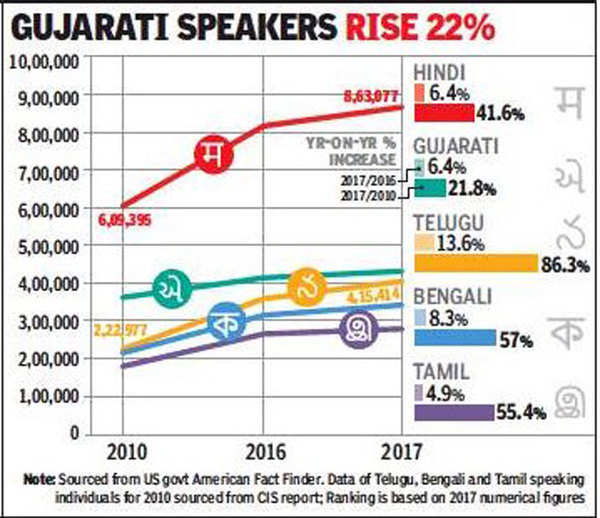- News
- India News
- Hindi most spoken Indian language in US, Telugu speakers up 86% in 8 years
Trending
This story is from September 21, 2018
Hindi most spoken Indian language in US, Telugu speakers up 86% in 8 years
Hindi continues to be the most widely spoken Indian language in the US, followed by Gujarati and Telugu. However, in terms of percentage increase, if the data of 2010 is compared with the most recent figures for 2017, the number of Telugu speaking individuals has risen the most — by 86%.

Representative image
Key Highlights
- Hindi continues to be the most widely spoken Indian language in the US, followed by Gujarati and Telugu
- According to a report, over a seven-year period from 2010, the number of Telugu speakers has risen exponentially by 86%
- The corresponding rise as regards Hindi and Gujarati speakers was just 42% and 22% respectively
MUMBAI: Hindi continues to be the most widely spoken Indian language in the US, followed by Gujarati and Telugu. However, in terms of percentage increase, if the data of 2010 is compared with the most recent figures for 2017, the number of Telugu speaking individuals has risen the most — by 86%.
American Community Survey (ACS) data, recently released by the US Census Bureau for 2017 — it measures the US population as of July 1, 2017 — shows that nearly 21.8% of residents in US aged over five (including nativeborn, legal and illegal immigrants) spoke a language other than English at home.Of the total populace of 30.5 crore, 6.7 crore spoke a foreign language at home.

In FY 2016, with 6.5 crore out of a total populace of 30.3 crore speaking a foreign language at home, the percentage was slightly lower at 20.6%. Hindi had 8.63 lakh speakers in the US, followed by Gujarati (4.34 lakh) and Telugu (4.15 lakh).
TOI in its edition dated September 17, had reported that
According to CIS, in America’s five largest cities, 48% of the residents speak a language other than English at home. For instance, in Los Angeles it is 59%, in New York and Houston it stands at 49%. TOI for the purpose of its analysis has primarily relied on the data available on the US Census Bureau-American Fact Finder website.
However, for 2010, this website did not show some Indian languages, which didn’t then have a large speaking populace — like Telugu, Bengali and Tamil but clubbed them as ‘other Indic languages’. For this breakup, TOI has relied on the CIS report.
ACS is the largest survey undertaken by the US government each year and includes over 20 lakh households.
While Bengali and Tamil in numeric terms were not the top-three Indian languages spoken in the US, the number of individuals speaking this language has risen by 57% and 55% to stand at 2.23 lakh and 1.84 lakh speakers respectively.
However, it should be noted that individuals from countries other than India also speak these two languages (Such as primarily those from Bangladesh for Bengali. Tamil is also widely spoken in Sri Lanka, Singapore and Malaysia). The US Census Board does not provide a linguistic cum country-wise breakup. As Urdu and Punjabi speaking populace in the US is anecdotally said to hail primarily from Pakistan, TOI has ignored these statistics in its analysis.
According to a few Immigration experts, one of the possible reasons for the significant rise in the Telugu speaking population is that many employees in the technology sector, which is a major employer of H-1B visa holders, hail from Andhra Pradesh.
American Community Survey (ACS) data, recently released by the US Census Bureau for 2017 — it measures the US population as of July 1, 2017 — shows that nearly 21.8% of residents in US aged over five (including nativeborn, legal and illegal immigrants) spoke a language other than English at home.Of the total populace of 30.5 crore, 6.7 crore spoke a foreign language at home.

In FY 2016, with 6.5 crore out of a total populace of 30.3 crore speaking a foreign language at home, the percentage was slightly lower at 20.6%. Hindi had 8.63 lakh speakers in the US, followed by Gujarati (4.34 lakh) and Telugu (4.15 lakh).
The Center for Immigration Studies (CIS), which is viewed as an anti-immigration thinktank, has analysed this data, specifically comparing the statistics of 2017 with 2010. As per its report, over a seven-year period from 2010, the number of Telugu speakers has risen exponentially by 86%. The corresponding rise as regards Hindi and Gujarati speakers was just 42% and 22% respectively.
TOI in its edition dated September 17, had reported that
26.10 lakh of the US population were born in India (this figure did not include those having Indian parents but born in the US). In the backdrop of this statistic, at least 33% of the Indians in the US speak Hindi, nearly 17% speak Gujarati and Telugu. CIS reports that the total figure of those who speak a foreign language has more than doubled since 1990 and almost tripled since 1980.
According to CIS, in America’s five largest cities, 48% of the residents speak a language other than English at home. For instance, in Los Angeles it is 59%, in New York and Houston it stands at 49%. TOI for the purpose of its analysis has primarily relied on the data available on the US Census Bureau-American Fact Finder website.
However, for 2010, this website did not show some Indian languages, which didn’t then have a large speaking populace — like Telugu, Bengali and Tamil but clubbed them as ‘other Indic languages’. For this breakup, TOI has relied on the CIS report.
ACS is the largest survey undertaken by the US government each year and includes over 20 lakh households.
While Bengali and Tamil in numeric terms were not the top-three Indian languages spoken in the US, the number of individuals speaking this language has risen by 57% and 55% to stand at 2.23 lakh and 1.84 lakh speakers respectively.
However, it should be noted that individuals from countries other than India also speak these two languages (Such as primarily those from Bangladesh for Bengali. Tamil is also widely spoken in Sri Lanka, Singapore and Malaysia). The US Census Board does not provide a linguistic cum country-wise breakup. As Urdu and Punjabi speaking populace in the US is anecdotally said to hail primarily from Pakistan, TOI has ignored these statistics in its analysis.
According to a few Immigration experts, one of the possible reasons for the significant rise in the Telugu speaking population is that many employees in the technology sector, which is a major employer of H-1B visa holders, hail from Andhra Pradesh.
End of Article
FOLLOW US ON SOCIAL MEDIA










